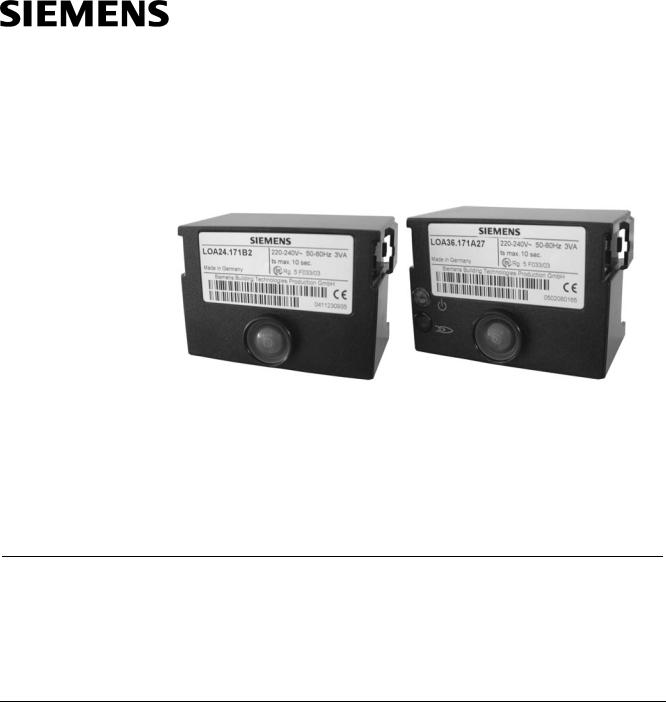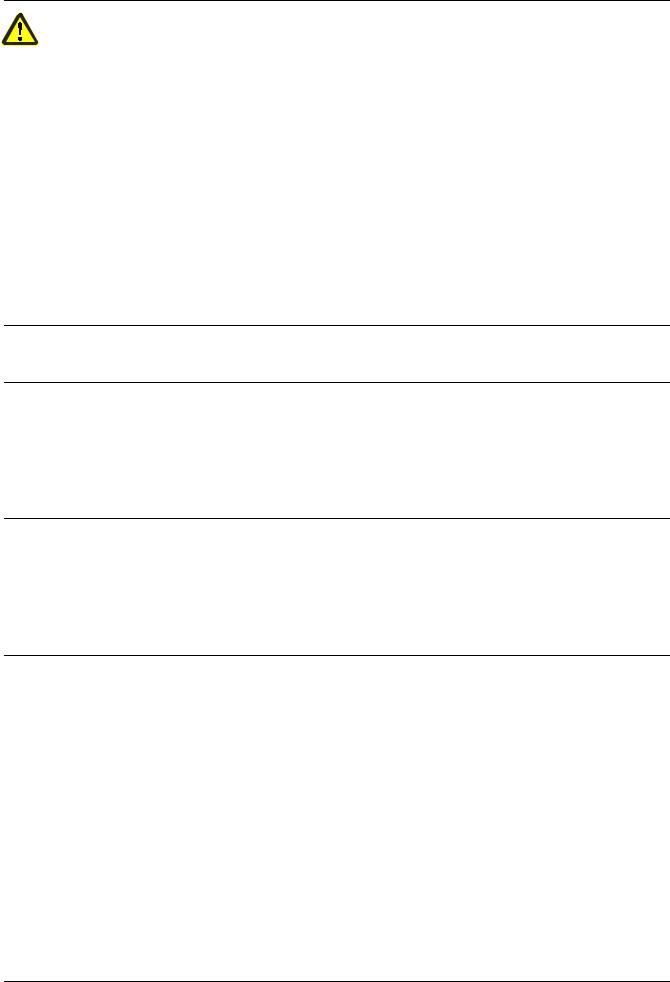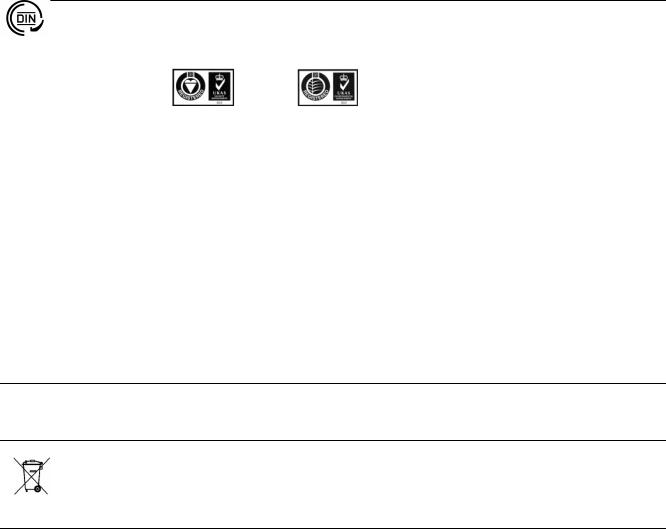Siemens Oil Burner Control Service Manual

7118
LOA2... |
LOA3... |
Oil Burner Controls |
LOA2... |
|
LOA3... |
Oil burner controls for the supervision, startup and control of 1- or 2-stage forced draft oil burners in intermittent operation.
Oil throughput up to 30 kg/h.
The LOA2... / LOA3... and this Data Sheet are intended for use by OEMs which integrate the oil burner controls in their products.
Use, features
Use
General features
Specific features
CC1N7118en
16.12.2005
The LOA... are used for the startup, supervision and control of 1- or 2-stage forced draft oil burners in intermittent operation.
Yellow-burning flames are supervised with photoresistive detectors QRB..., blueburning flames with blue-flame detectors QRC...
-Forced draft oil burners conforming to EN 267
-Oil atomization burners in monoblock design conforming to EN 230
-Undervoltage detection
-Bridging contact for oil preheater (not with LOA28.173A27)
-Special versions including models for incinerator plant and flash-steam generators
-LOA36... with color LED for indicating flame strength and operation
Building Technologies
HVAC Products

Warning notes
To avoid injury to persons, damage to property or the environment, the following warning notes should be observed!
Do not open, interfere with or modify the unit!
•All activities (mounting, installation and service work, etc.) must be performed by qualified staff
•Before making any wiring changes in the connection area of the LOA..., completely isolate the unit from the mains supply (all-polar disconnection)
•Ensure protection against electric shock hazard by providing adequate protection for the burner control’s connection terminals
•Each time work has been carried out (mounting, installation, service work, etc.), check to ensure that wiring is in an orderly state and make the safety checks as indicated in «Commissioning notes» above
•Press the lockout reset button / operating button only manually (applying a force of no more than 60 N), without using any tools or pointed objects
•Fall or shock can adversely affect the safety functions. Such units must not be put into operation, even if they do not exhibit any damage
Mounting notes
•Ensure that the relevant national safety regulations are complied with
Installation notes
•Do not mix up live and neutral conductors
•Always run high-voltage ignition cables separately while observing the greatest possible distance to the unit and to other cables
•Install switches, fuses, earthing, etc., in compliance with local regulations
•Ensure that the maximum permissible amperages will not be exceeded (refer to «Technical data»)
Electrical connection of flame detectors
It is important to achieve practically disturbanceand loss-free signal transmission:
•Never run the detector cable together with other cables
–Line capacitance reduces the magnitude of the flame signal
–Use a separate cable
•Observe the permissible lengths of the flame detector cables (refer to Data Sheets N7714 (QRB...) and N7716 (QRC...))
Commissioning notes
•When commissioning the plant, when carrying out maintenance work, or after longer off periods, make the following safety checks:
|
Safety check |
Anticipated response |
a) |
Burner startup with flame detector |
Lockout at the end of «TSA» |
|
darkened |
|
b) |
Burner startup with flame detector |
Lockout after approx. 40 seconds |
|
exposed to extraneous light |
|
c) |
Simulation of flame failure during |
Repetition followed by lockout at the |
|
operation. For that purpose, darken |
end of «TSA» |
|
the flame detector during operation |
|
|
and maintain this state |
|
2/11
Building Technologies |
CC1N7118en |
HVAC Products |
16.12.2005 |

Standards and certificates
|
Conformity to EEC directives |
|
|
|
- Electromagnetic compatibility EMC (immunity) |
89 / 336 |
/ EEC |
|
- Low-voltage directive |
73 / 23 / |
EEC |
|
ISO 9001: 2000 |
|
ISO 14001: 2004 |
||
Cert. 00739 |
|
Cert. 38233 |
||
|
|
|
|
|
Type reference |
|
|
|
|
|
|
|
|
|
LOA24.171B17 |
x |
|
||
LOA24.171B27 |
x |
|
||
LOA24.173A27 |
x |
|
||
LOA24.571C27 |
x |
|
||
LOA25.173C17 |
--- |
|
|
|
LOA25.173C27 |
--- |
|
|
|
LOA26.171B27 |
x |
|
||
LOA28.173A27 |
x |
|
||
LOA36.171A27 |
x |
|
||
Service notes
•Use the KF... test adapters for short periods of time only
Disposal notes
The unit contains electrical and electronic components and must not be disposed of together with domestic waste.
Local and currently valid legislation must be observed.
Mechanical design
The housing is made of impact-proof, heat-resistant and flame-retarding plastic.
The oil burner control is of plug-in design and engages audibly in its base.
The housing accommodates the
-thermal-electric sequence switch
-flame signal amplifier with the flame relay
-lockout reset button with its integrated fault indication lamp
|
3/11 |
|
|
Building Technologies |
CC1N7118en |
HVAC Products |
16.12.2005 |

Type summary
The type references given below apply to burner controls without base and without flame detector.
Version |
Type reference |
Voltage |
Under- |
CE |
t1 |
t3 |
TSAmax. |
t3n |
t3n´ |
t4 |
|
|
|
voltage |
|
|
|
|
|
|
|
|
|
|
detection |
|
|
|
|
|
|
|
Standard version |
LOA24.171B27 ²) |
AC 220 V |
X |
X |
13 s |
13 s |
10 s |
20 s |
--- |
20 s |
|
LOA24.171B17 ²) |
AC 110 V |
X |
X |
13 s |
13 s |
10 s |
20 s |
--- |
20 s |
|
LOA24.173A27 |
AC 220 V |
X |
X |
13 s |
13 s |
10 s |
20 s |
2 s |
20 s |
With remote reset facility |
LOA26.171B27 ²) |
AC 220 V |
X |
X |
13 s |
13 s |
10 s |
20 s |
--- |
20 s |
|
LOA36.171A27 |
AC 220 V |
X |
X |
13 s |
13 s |
10 s |
20 s |
--- |
20 s |
For flash-steam generators |
LOA24.571C27 |
AC 220 V |
X |
X |
5 s |
6 |
10 s |
20 s |
--- |
20 s |
For incinerator plant |
LOA25.173C27 ¹) |
AC 220 V |
X |
--- |
13 s |
13 s |
10 s |
--- |
2 s |
20 s |
|
LOA25.173C17 ¹) |
AC 110 V |
X |
--- |
18 s |
13 s |
10 s |
--- |
2 s |
20 s |
|
LOA28.173A27 ¹) |
AC 220 V |
X |
--- |
13 s |
13 s |
10 s |
--- |
2 s |
20 s |
Legend |
¹) |
LOA25... and LOA28... are designed for use on incinerator plant where lockout by extraneous light is not desired. |
|
²) |
These types of oil burner controls are not covered by EN 230 |
|
IRD1010 infrared flicker detectors can also be used |
|
|
t1 |
Prepurge time |
|
t3 |
Preignition time |
|
t3n |
Long postignition time |
|
t3n´ |
Short postignition time |
|
t4 |
Interval from establishment of flame to the release of «BV2» |
|
TSAmax. |
Ignition safety time |
4/11
Building Technologies |
CC1N7118en |
HVAC Products |
16.12.2005 |
